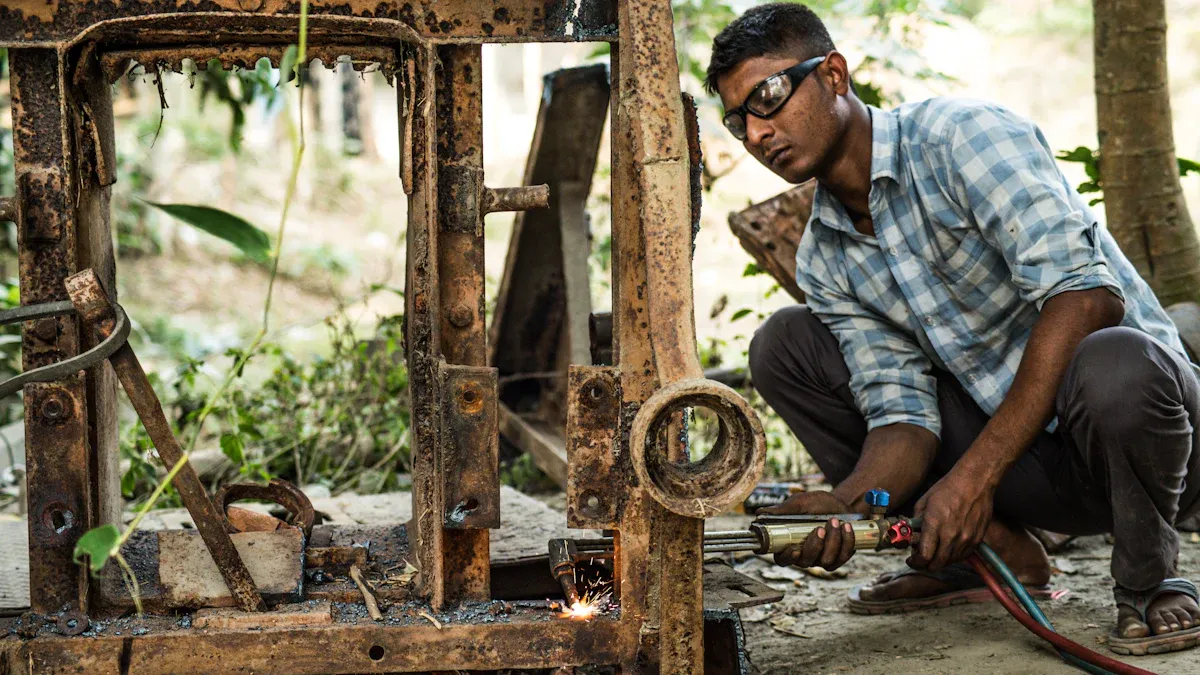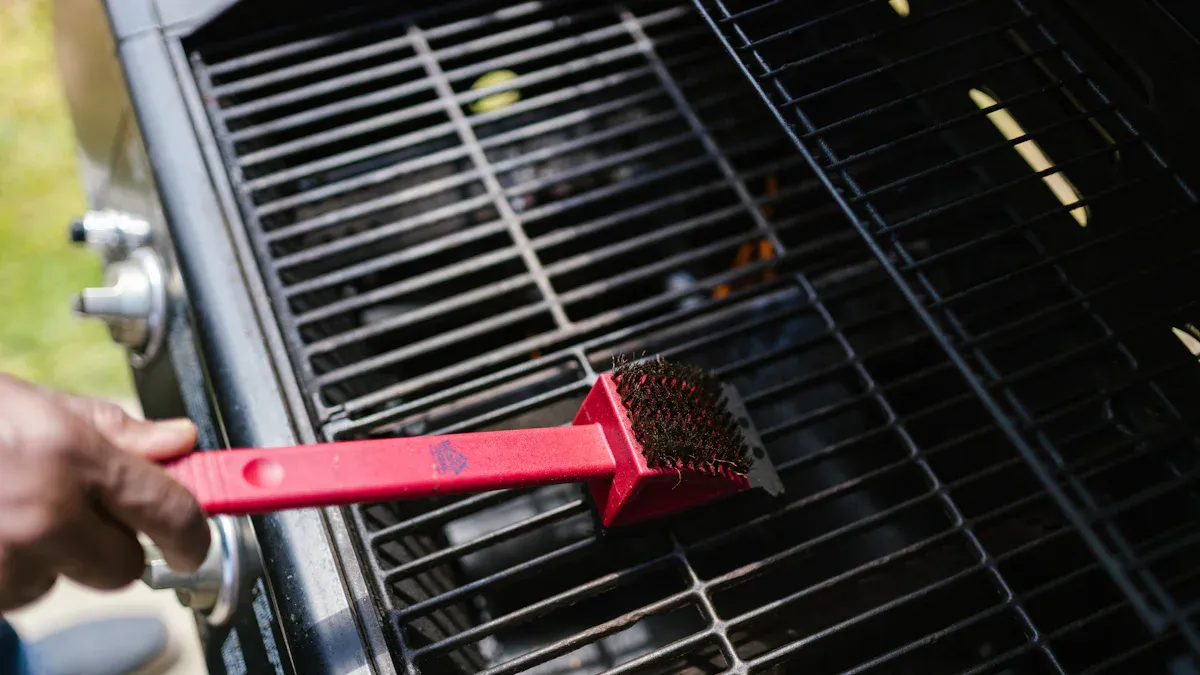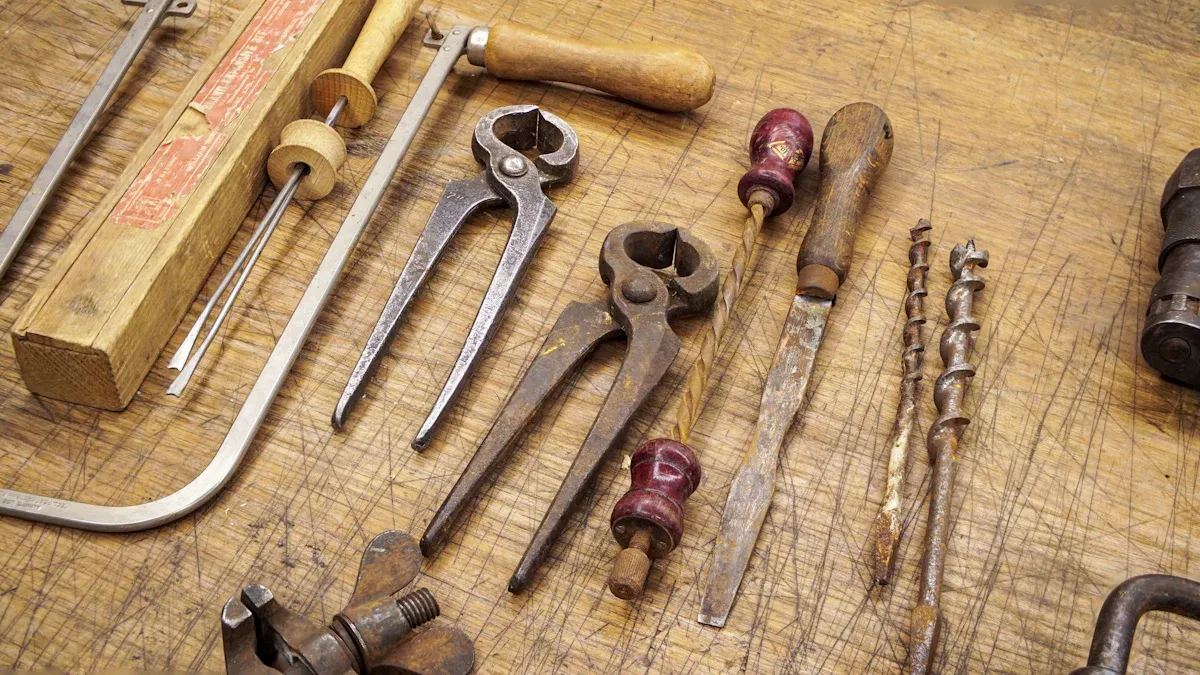
If you want to know how to remove rust from your bike frame, you are in the right place. Rust on bike frame looks scary, but most of the time, it only affects the surface. You can handle it at home with simple tools and a bit of patience. Rust forms slowly, so you usually have plenty of time to act before any real damage happens. Still, you should not wait too long. The sooner you learn how to remove rust, the easier it will be to remove rust from bike frame and keep your ride looking sharp.
Key Takeaways
Rust happens on bike frames from water, salt, dirt, and scratches. Always clean your bike after you ride in the rain. Dry your bike well every time.
Use gentle things like baking soda paste or vinegar for small rust spots. Use stronger products or tools for bad rust. Protect your hands when you work. Make sure you work where there is fresh air.
Scrub small spots of rust carefully. After you finish, put on sprays or wax to keep rust away.
Look at your bike often to check for rust. Check hidden places too. Fix small rust fast before it gets worse.
Keep your bike inside or under a cover. Make sure it stays dry. Clean and oil your bike often. This helps stop rust and keeps your bike working well.
Why Rust on Bike Frame Happens
Causes of Rust
You might wonder why rust on bike frames shows up so often. The answer is simple: bikes face a lot of tough conditions. When you ride in the rain or leave your bike outside, moisture gets on the frame. If you live near the ocean or in a place where roads get salted in winter, salt can speed up the rusting process. Dirt and grime also trap water against the metal, making things worse.
Moisture from rain, puddles, or even sweat can start rust on bike frame.
Salt from ocean air or winter roads breaks down the frame’s protective layers.
Dirt and mud hold water against the frame, helping rust form faster.
Scratches in the paint let air and water reach the metal underneath.
Tip: Always dry your bike after a wet ride and clean off any dirt or salt. This simple habit can help stop rust on bikes before it starts.
Effects on Bike Performance
Rust on bike frames does more than just look bad. It can change how your bike feels and works. Surface rust on bike frame usually does not cause big problems right away. But if you ignore it, rust can eat deeper into the metal over time.
Deep rust weakens the frame and can make your bike unsafe.
Rust on bikes can spread to chains, gears, and bolts, making them harder to move and causing annoying noises.
For e-bikes, rust can even mess up electrical parts if water gets inside.
Most of the time, you will notice creaking or flexing before rust causes real danger. Regular checks and cleaning help you catch problems early. If you see rust on bike frames, act fast to keep your ride safe and smooth.
Step-by-Step Bike Rust Removal Process

Tools and Materials Needed
Before you start, gather everything you need. Having the right tools makes the job easier and safer. Here’s a handy table to help you get organized:
Tool/Material | Purpose/Use | Notes/Precautions |
|---|---|---|
Steel Wool | Deep rust removal | Can scratch paint, use gently |
Nylon Pad | Rust removal on painted areas | Safe for paint, needs more effort |
Baking Soda & Vinegar | Removing surface rust | Great for light rust, easy to find at home |
Protective Spray/Car Wax | Prevent future rust | Apply after cleaning, reapply regularly |
Gloves | Safety equipment | Protects your hands from chemicals |
Well-ventilated Area | Safety precaution | Avoid breathing in fumes from rust removers |
Primer and Paint | Post-rust removal protection | Seals frame, keeps moisture out |
Tip: Always wear gloves and work in a space with good airflow. This keeps you safe from harsh chemicals and strong smells.
Preparation Steps
Getting ready is just as important as the actual cleaning. Here’s what you should do before you begin:
Remove any detachable parts like wheels, chains, and pedals. This gives you better access to the frame and keeps other parts safe.
Put on gloves to protect your hands.
Make sure you work in a well-ventilated area. Open a window or work outside if you can.
Inspect the bike frame closely. Look for all the rusty spots so you don’t miss any during the step-by-step cleaning process.
Clean the frame with warm, soapy water. Use a sponge or cloth to wipe away dirt and grime. Dry the frame completely with a towel.
Safety First: Never skip gloves or ventilation. Some rust removers have strong fumes that can make you feel sick.
Removing Rust from a Bike Frame
Now you’re ready to tackle the rust. Here’s a simple step-by-step cleaning process you can follow:
Put on your gloves and safety glasses.
Check the frame for all rusty areas.
Mix baking soda and vinegar to make a thick paste. Spread it over the rust spots and let it sit for about 15 minutes.
Use a nylon pad or steel wool to scrub the rust in small circles. Be gentle on painted areas to avoid scratches.
Rinse the frame with clean water and dry it right away with a towel.
If you still see rust, repeat the process or try a stronger method like a commercial rust remover.
Once all the rust is gone, apply a protective spray or car wax to seal the frame.
Note: If you use a commercial rust remover, always follow the instructions on the label. Never mix different chemicals together.
Clean Rust from a Bike Frame: Methods
You have several options for removing rust from a bike frame. Some work better for light rust, while others are best for tough spots. Here’s a quick guide:
Baking Soda Paste: Mix baking soda with water (or lemon juice) to make a paste. Spread it on the rust, wait 10-15 minutes, then scrub and rinse. This method is gentle and safe for most frames.
Vinegar or Coca Cola: Spray or soak the rusty area with vinegar or cola. Let it sit for about 10 minutes. Scrub with a toothbrush or aluminum foil, then rinse well. This works well for small, stubborn spots.
WD-40: Spray WD-40 on the rust, let it soak, then scrub with a nylon pad or steel wool. Wipe off any leftover oil before painting or sealing.
Commercial Rust Removers: These products work fast and are strong. Wear gloves and use them only in a well-ventilated area. Rinse the frame well after use.
Rust Converters: These turn rust into a stable surface you can paint over. Good for deep rust, but always follow the product instructions.
Angle Grinder with Brass Brush: For heavy rust on unpainted frames, use this tool carefully. It removes rust quickly but can damage paint and metal if you press too hard.
Aluminum Foil: Dip foil in water or vinegar and rub it on the rust. The foil reacts with rust and helps lift it off.
Lemon Juice: The acid in lemon juice breaks down rust. Apply it, let it sit, then scrub and rinse.
Electrolysis: This is a more advanced method using electricity to remove rust. Most people don’t need this for regular bike care.
Painted vs. Unpainted Frames: Use gentle methods like baking soda or a nylon pad on painted frames. For unpainted frames, you can use steel wool or a brass brush, but always seal the metal after cleaning.
Aftercare and Protection
You’ve finished removing rust from a bike frame, but your job isn’t done yet. Aftercare keeps your bike looking good and stops rust from coming back.
Dry the frame completely with a soft microfiber cloth. Don’t let it air dry—water spots can lead to new rust.
Use compressed air or a motorcycle dryer to blow water out of hidden spots, like joints and cable guides.
Apply a layer of car wax or a protective spray. This creates a barrier against moisture and dirt.
Polish the frame to fill in tiny scratches and make it shine.
Relubricate the chain and moving parts to keep everything running smoothly.
Store your bike indoors or cover it if you keep it outside.
Common Mistakes to Avoid:
Don’t use rough sandpaper on painted frames. It can scratch and damage the finish.
Always remove any wax or oil before painting the frame.
Seal the frame right after cleaning to stop rust from coming back.
Taking these steps after you clean rust from a bike frame will help your bike last longer and look better. Regular care and quick action when you spot rust on bike frame make a big difference.
Assessing Rust Severity

Surface vs. Deep Rust
Not all rust is the same. You need to know what you are dealing with before you start fixing your bike. Here’s how you can tell the difference:
Surface rust looks like small orange or brown spots. It only affects the outer layer of your bike frame. You can usually scrape it off, and the metal underneath will look fine or just a little pitted.
Deep rust goes further. It can eat into the metal and even hide inside the tubes of your frame. If you shake your bike and hear a rattling sound, you might have rust flakes inside. That’s a sign of serious corrosion.
Sometimes, deep rust causes pitting or even holes. You can test this by gently poking the area with a sharp tool. If the metal feels soft or flakes away, the rust is deep.
Surface rust forms a crust you can remove. Deep rust means the metal is breaking down from the inside.
Tip: Hi-ten steel frames handle surface rust better than thinner Cromoly frames. Surface rust is mostly cosmetic, but deep rust, especially inside the frame, can mean big trouble.
Repair or Replace?
You might wonder if you should fix your bike or start looking for a new frame. Here’s a simple way to decide:
Check the frame for rust, especially in important spots like the seat tube, chainstays, and head tube.
If you see only minor rust, you can usually repair it at home.
If you find deep rust, cracks, or dents, it’s time to get a professional opinion. Cracks plus rust almost always mean you need a new frame.
If you spot rust inside the frame, try wiping inside the seat tube with a rag. An orange tint means rust is there.
Regular checks and quick cleaning help you catch rust on bike frame before it gets too bad.
🚲 If you ever find a crack, stop riding right away. You can ask about a warranty, talk to a framebuilder, or look for a replacement. Sometimes, fixing a badly rusted frame costs more than buying a new one.
Preventing Rust on Bike Frame
Maintenance Tips
You can keep your bike looking fresh and rust-free with a few easy habits. Regular cleaning makes a huge difference. Use diluted dish soap or a bike-specific cleaner to wash away dirt and grime. Water helps, but avoid blasting your bike with high-pressure sprays. That can push water into places you don’t want it.
Here are some simple rust removal tips for your routine:
Clean your bike frame after every few rides, especially if you’ve been out in the rain or mud.
Lubricate moving parts like the chain. Pick a wet lube for rainy days and a dry lube for sunny rides. Always wipe off extra lube so dirt doesn’t stick.
Inspect your bike before every ride. Check spots like the bottom bracket, chainstays, and seat tube for early signs of rust.
Do a deeper inspection every three months. Take off the seatpost and handlebars to look for hidden rust.
If you live near the ocean or ride in winter, check and clean your bike more often. Salt and moisture speed up rust.
Tip: A quick wipe-down after a wet or salty ride keeps rust away and helps your bike last longer.
Protective Coatings and Storage
You can protect your bike frame with special coatings. Petroleum-based sprays like WD-40 work well on bare metal. Bike frame protectants are easy to find online and simple to use. Spray protectants go on fast, but you may need to reapply them every few months.
For long-term protection, try a three-step system. First, use a rust remover that also adds a zinc layer. Next, paint on a rust-inhibitive coating. Finish with a UV-stable topcoat. This combo blocks moisture and sunlight, keeping rust off for years.
Storing your bike the right way matters too. Keep it indoors or under a shelter. Use a breathable, waterproof cover to stop moisture and sun damage. Always dry your bike before storage, especially after wet rides. Seal any paint chips or scratches so water can’t sneak in.
Here’s a quick table to help you remember:
Storage Tip | Why It Works |
|---|---|
Indoor or shaded storage | Keeps moisture and sun away |
Breathable bike cover | Blocks water, lets air flow |
Dry before storing | Removes rust-causing moisture |
Seal paint chips | Stops water from reaching metal |
You’ll find that these rust removal tips and storage habits make a big difference. Your bike will stay strong, shiny, and ready for your next adventure.
How to Remove Rust: Product Effectiveness
WD-40 and Alternatives
WD-40 is not just for squeaky doors. It can help remove small rust spots from your bike frame. If you see light rust on painted parts, WD-40 can loosen it. Spray it on the rust and wait a few minutes. Then scrub the spot gently. Many people use WD-40 after riding in the rain. For tougher rust, scrub with aluminum foil first. Then use WD-40 to finish the job.
Here’s a table that shows how WD-40 compares to other products:
Product | Best For | How to Use | Notes |
|---|---|---|---|
WD-40 | Minor surface rust | Spray, wait, scrub | Safe for paint, not for deep rust |
Vinegar | Light rust, small spots | Soak or spray, scrub | Cheap, natural, needs rinsing |
Baking Soda | Early rust, gentle use | Make paste, apply, scrub | Safe, good for painted frames |
Commercial Remover | Heavy or deep rust | Apply, wait, scrub | Strong, needs safety gear |
Tip: WD-40 is great for small rust spots. For deep rust, use a commercial remover or sand the area.
Natural vs. Chemical Solutions
You can pick between natural and chemical ways to remove rust. Natural choices like vinegar, lemon juice, and baking soda are safe and cheap. They work best for new or light rust but take more time. Chemical removers work fast and clean heavy rust. But you must wear gloves and eye protection. Always work where air can move.
Method | Effectiveness | Cost | Time Needed | Safety |
|---|---|---|---|---|
Lemon Juice/Baking Soda | Moderate | Low | High | Very safe |
WD-40 | Moderate | Moderate | Moderate | Safe |
Commercial Remover | High | Moderate | Low | Use with care |
Use natural ways for small, new rust spots.
Try WD-40 for quick fixes on painted frames.
Remember: Never mix chemical and natural products. Use only one method at a time to stay safe.
You can keep your bike looking great and rust-free with a few simple habits. Here’s a quick recap to help you get started:
Clean and dry your bike after every ride, especially if it gets wet.
Lubricate moving parts and check for early signs of rust.
Regular care keeps your bike strong and ready for every adventure. Most bikes can shine again with a little effort and the right approach! 🚲
FAQ
How often should you check your bike for rust?
You should check your bike for rust every month. If you ride in wet or salty conditions, look for rust every week. Early checks help you catch small spots before they spread.
Can you use household items to remove rust?
Yes! Baking soda, vinegar, and lemon juice work well on light rust. You can scrub with a nylon pad or aluminum foil. These items are safe for most bike frames.
Is it safe to ride a bike with rust on the frame?
Small rust spots are usually safe. Deep rust or cracks can make your bike dangerous. Always check the frame before riding. If you see holes or soft spots, stop riding and get advice.
What should you do if rust keeps coming back?
Try cleaning and drying your bike after every ride. Apply a protective spray or wax. Store your bike indoors or use a cover. If rust returns, check for hidden moisture or scratches.
See Also
Effective Methods To Keep Your Bike Frame Safe
Essential Tips For Caring And Maintaining Steel Bike Frames
Best Advice To Paint Carbon Frames Without Harm
